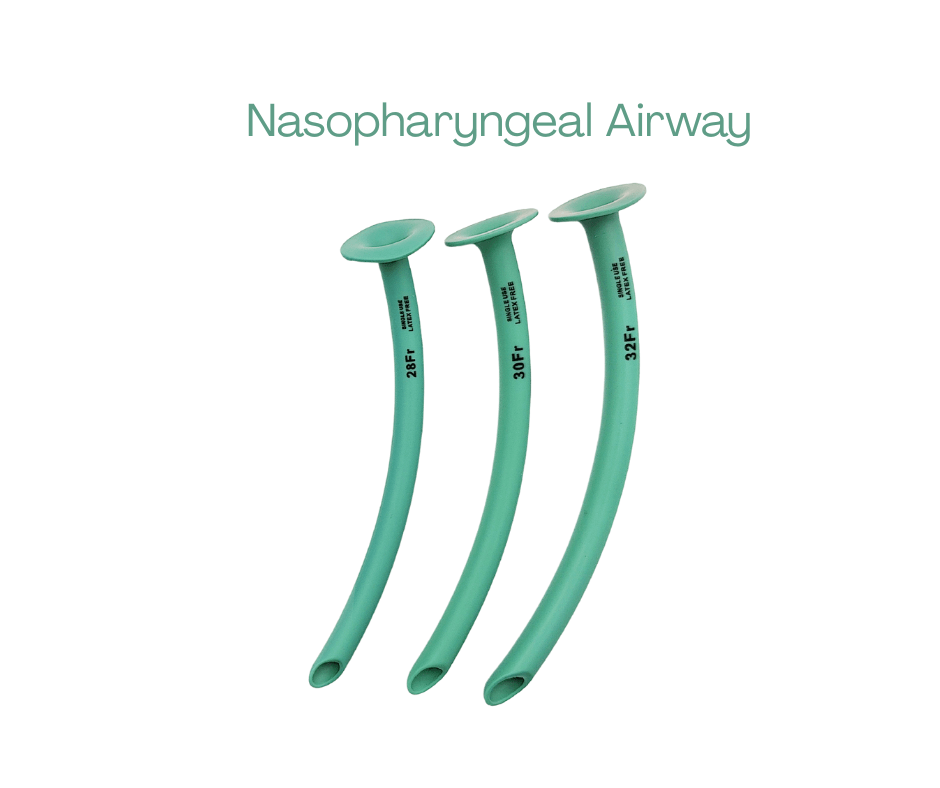Nasopharyngeal airways (NPAs) play a great role in patients of all ages. Although both adults and elderly patients may require NPAs in scenarios, differences in physiology, disease prevention, and treatment needs result in significant variations in their use. Besides, elderly patients often come with some chronic conditions, which can make insertion more challenging. In this article, to know these differences can improve treatment effectiveness and reduce complications. What is a Nasopharyngeal Airway? A nasopharyngeal airway (NPA) is inserted into the nasal passage to maintain an open airway. It is commonly used in emergency care, anesthesia, and patients with respiratory impairment. PVC nasopharyngeal airways are one of the most popular choices because of their durability, biocompatibility, and prices. However, when choosing it, you should consider usage, patients' ages, conditions, and precautions, etc. Key Differences in NPA Use Between Adults and Elderly Patients Physiological Differences and Tube Selection Adults Adults have wider nasal passages and thicker nasal mucosa, allowing for larger tube diameters. NPAs with a 28-32Fr diameter are recommended to ensure sufficient airflow. Since the adult nasal cavity is relatively firm, a lubricant should be applied to reduce friction during insertion. Elderly Patients Compared to younger adults, elderly patients have thinner nasal tissues and fragile blood vessels, making them prone to nasal bleeding or injury. A smaller diameter (24-28Fr) is recommended. Due to age-related soft tissue degeneration, gentle insertion is essential to prevent mucosal damage. Respiratory Function and Indications Adults Suitable for mild airway obstruction, especially in semi-conscious patients who still have some breathing ability. Commonly used in postoperative recovery, emergency care (e.g., trauma, alcohol intoxication, etc.). Elderly Patients More prone to hypoxemia due to reduced lung function, requiring long-term airway management. Commonly used for patients with COPD (Chronic Obstructive Pulmonary Disease), swallowing difficulties, or frequent nighttime apnea. Often used with oxygen therapy to improve ventilation efficiency. Insertion Technique and Care Adults Ensure the nasal passage is clear before insertion and apply lubricant to reduce irritation. Adjust the angle between 45-90 degrees to avoid excessive force that could damage the nasal cavity. For prolonged use, alternate nostrils periodically to prevent pressure injuries. Elderly Patients Due to dry nasal passages, pre-humidification is recommended. A softer PVC NPA can help reduce irritation. The insertion angle should not exceed 60 degrees to minimize nasal trauma. Monitor for nasal bleeding or mucosal damage. If issues arise, consider using a smaller size or switching to an alternative airway management method. Complication Risks and Prevention For Adults Common risks include nasal mucosal damage, aspiration, and gag reflex activation. Prevention: Choose the correct size, ensure adequate lubrication, and insert to the appropriate depth. For Elderly Patients More susceptible to nasal bleeding, infections, and soft tissue damage due to fragile blood vessels. Prevention: Use softer materials, such as silicone NPAs, to reduce irritation. Avoid repeated insertions; use humidified oxygen therapy when necessary. Regularly assess airway condition to prevent long-term pressure ulcers. How to Choose the Right Nasopharyngeal Airway When selecting an NPA, consider the following key factors to ensure optimal performance and patient comfort: Diameter (Fr) Adults: 28-32Fr for sufficient airflow and minimal resistance. Elderly patients: 24-28Fr to reduce irritation and the risk of injury. Material PVC is a common choice for nasopharyngeal airways due to its softness, non-toxicity and durability. PVC nasopharyngeal airways are suitable for short-term use and can also be used for long-term use in certain situations, especially when frequent replacement is required, to help reduce the risk of respiratory complications. Silicone is softer and more biocompatible, suitable for long-term wear and reduces irritation to nasal tissue. Thermoplastic elastomers (TPE) combine the advantages of silicone and PVC, providing better softness and durability while reducing the risk of allergies. The doctor should choose the material based on the patient's condition and age. Length The NPA should be long enough to reach the airway but not so long that it interferes with the throat. Selecting the right length improves patient comfort and ventilation efficiency. It should be chosen based on the patient's height and anatomical structure. Tip Design NPAs with a smooth, beveled tip reduce insertion trauma and improve patient comfort. A well-designed tip enhances both safety and effectiveness. Disposable vs. Reusable Disposable NPAs are safer and reduce the risk of infection, making them ideal for hospitals and emergency settings. Reusable NPAs are more cost-effective but require strict disinfection protocols. Infection control measures should be prioritized in medical environments. Conclusion You've known the differences in NPA use between adults and elderly patients through the above-mentioned. Therefore, using the right nasopharyngeal airway and proper techniques can reduce complications and improve patient comfort. Bever Medical specializes in high-quality medical NPAs and provides OEM services. Our nasopharyngeal airways meet international medical standards, offering soft, comfortable solutions for all patient needs. Bever Medical delivers professional solutions for hospitals, emergency care, and personal use. Contact us to learn more!
View More +-
17 Mar 2025
Tons of people suffer breathing difficulties while sleeping, which can impact sleep quality and even pose health risks. If you experience sudden shortness of breath, you should seek immediate medical attention; if you have chronic sleep-related breathing problems, such as sleep apnea, they can be managed and treated effectively. This article shares common causes of breathing difficulties and effective solutions with you. airway management products Common Causes of Breathing Difficulty 1. Obstructive Sleep Apnea (OSA) Obstructive Sleep Apnea (OSA) is a common sleep disorder caused by the collapse or partial obstruction of the upper airway. Patients experience repeated episodes of breathing cessation during sleep, leading to poor sleep quality and potential health complications such as hypoxemia, fatigue, and high blood pressure. 2. Upper Airway Obstruction Structural abnormalities from the norm within the nasal depth, throat, or larynx can cause airway narrowing amid rest, confining the airflow. Common causes include: Nasal blockage or nasal polyps Swelling of the nasal mucosa and increased discharges ruin the wind stream. Broadened tonsils Decreases space within the throat, making breathing troublesome. Expansive tongue or delicate sense of taste unwinding Increments the probability of aviation route hindrance amid rest. Unfavorably susceptible or incessant rhinitis Determined nasal blockage influences typical breathing. 3. Neuromuscular Diseases Certain neurological conditions, such as Amyotrophic Lateral Sclerosis (ALS) and Parkinson's disease, can disable respiratory muscle work, expanding the chance of aviation route collapse and breathing troubles. Nasopharyngeal Airway Management A nasopharyngeal airway (NPA) is one of the useful airway management products, embedded into the nasal entry to preserve an open airway. Made from delicate medical-grade silicone or PVC, the adjustable nasopharyngeal airway is becoming more widely utilized due to its preferences over conventional NPAs: Flexible length for distinctive patients Not at all like fixed-length NPAs, movable NPAs can be customized to fit the patient's life structures, guaranteeing superior airway patency and comfort. Upgraded consolation Made from delicate silicone, lessening nasal divider disturbance, appropriate for long-term use and sensitive people. Flexible clinical applications Utilized in domestic care, crisis circumstances, anesthesia administration, and ICU aviation route support. Positive Airway Pressure Therapy (CPAP/BiPAP) Continuous Positive Airway Pressure (CPAP) and Bilevel Positive Airway Pressure (BiPAP) are widely used for patients experiencing breathing difficulties due to OSA, Chronic Obstructive Pulmonary Disease (COPD), neuromuscular diseases, and other conditions that lead to insufficient ventilation. Key Benefits Keeps airways open: Prevents airway collapse with continuous or bilevel pressure, ensuring smooth breathing during sleep or rest. Improves oxygenation: Enhances alveolar ventilation, increases blood oxygen saturation, and reduces the risk of hypoxemia. Reduces apnea episodes: Effectively decreases the number of breathing interruptions in OSA patients, improving sleep quality. Eases breathing effort: BiPAP reduces CO2 retention in COPD patients, improves lung function, and alleviates respiratory fatigue. Suitable for long-term management: Can be used for home therapy, helping patients with chronic respiratory conditions maintain stable breathing function. Who Can Benefit? OSA patients COPD patients Individuals with neuromuscular diseases affecting respiratory function Patients with pulmonary hypertension or other conditions affecting breathing Oxygen Therapy Oxygen therapy involves delivering supplemental oxygen through nasal cannulas, masks, or high-flow devices to improve blood oxygen levels and alleviate hypoxemia. It is commonly used for COPD, pulmonary fibrosis, interstitial lung disease, heart failure, and other conditions that cause oxygen deficiency. Key Benefits Enhances oxygenation: Increases blood oxygen levels, relieving symptoms like shortness of breath, fatigue, and dizziness. Reduces heart strain: Prevents complications such as pulmonary hypertension and heart failure caused by prolonged low oxygen levels. Improves exercise tolerance: Helps patients with chronic respiratory diseases maintain better physical activity. Flexible application: Can be used at home, in hospitals, or emergency settings with adjustable oxygen delivery methods. Who Can Benefit? COPD patients Pulmonary hypertension patients Patients with pulmonary fibrosis or interstitial lung disease Individuals with severe heart failure-induced hypoxemia Bronchodilators Bronchodilators are medications that relieve airway constriction and improve lung ventilation. They are commonly used for asthma, COPD, and other conditions involving airway obstruction. Key Benefits Rapid relief of breathing difficulty: Expands the bronchi, improves airflow, and quickly alleviates acute shortness of breath. Long-term maintenance treatment: LABA and LAMA are used for chronic management in COPD and asthma patients. Multiple administration options: Available as inhalers, nebulizers, or oral medications for convenient use. Who Can Benefit? Asthma patients (for both acute attacks and long-term control) COPD patients (for chronic management) Individuals with bronchiectasis or other airway-narrowing conditions How to Choose the Right Treatment? Every patient’s condition is different, so treatment selection depends on a comprehensive assessment of medical history, symptom severity, pulmonary function tests, and other factors. Airway management needs: Adjustable nasopharyngeal airways are suitable for patients requiring customized airway support, such as long-term bedridden individuals or those under anesthesia. Acute airway obstruction or sudden breathing difficulties: Short-acting bronchodilators (SABA/SAMA) provide immediate relief. COPD or chronic respiratory impairment: Long-acting bronchodilators (LABA/LAMA) combined with oxygen therapy or BiPAP may be more appropriate. Sleep apnea or nighttime oxygen desaturation: CPAP or BiPAP devices help maintain airway patency and improve oxygenation. Chronic hypoxemia: Continuous oxygen therapy (e.g., high-flow nasal cannula or portable oxygen concentrators) is necessary to maintain oxygen levels and prevent complications. Conclusion Breathing difficulties can result from various causes, doctors should choose the right treatment way according to the patient's specific condition. If you are looking for medical-grade nasopharyngeal airway products, Bever Medical offers a wide range of solutions to meet different patient needs, a single catheter or nasopharyngeal airway kit. Contact us today for more information on high-quality airway management solutions!
View More + -
26 Mar 2025
A nasopharyngeal airway with a trumpet is a common device. Compared with the standard NPA, it has better comfort and safety. If you are still thinking about whether to invest in it, this article will analyze the market potential. Without further ado, take a look at it now. What Is a Nose Trumpet? A nose trumpet is a type of Nasopharyngeal Airway (NPA). It gets its name from its trumpet-like shape. This soft, flexible tube is inserted through the nose to keep the airway open. Unlike an Oropharyngeal Airway (OPA), which is placed in the mouth, a nose trumpet is better for patients who are awake or semi-conscious because it causes less discomfort. It always is made of medical-grade silicone or soft plastic, ensuring comfort and safety. Moreover, it has a good design of smooth and rounded tips to prevent injury. The great design is a flared end to stop over-insertion. Nose trumpet airway is available in multiple sizes to fit different patients. Where Is a Nose Trumpet Used? Emergency Care Time is critical in emergencies. The nasopharyngeal airway with trumpet is quick and easy to insert, making it a go-to tool for paramedics. It helps keep the airway open while other treatments are prepared. Surgery & Anesthesia During surgery or deep sedation, airway muscles relax. A nose trumpet helps prevent obstruction, keeping the airway clear. ICU & Critical Care For ICU patients, especially those needing long-term airway support, the NPA (trumpet type) provides a non-invasive option. It can sometimes reduce the need for a breathing tube. Home Care Some patients with sleep apnea use a nose trumpet as a temporary solution to improve airflow during sleep. Why Choose a Nose Trumpet? Easy to use It doesn't require special training, making it accessible for medical staff in various settings. Better Tolerance Since it enters through the nose, it avoids the discomfort of a mouthpiece. This makes it easier for awake or semi-conscious patients to tolerate. Cost-Effective A nose trumpet is affordable and can be sterilized for reuse in some cases, helping hospitals and clinics save money. Multi-Purpose It's not just for keeping the airway open. It can also help with suctioning secretions or administering medication. Market Potential & Challenges Growth Opportunities Increasing Demand: More awareness of airway management tools is driving demand. Technological Advances: New designs, like adjustable NPAs, are improving patient experience. Government Support: Investments in emergency care and hospital upgrades support market growth. Challenges Tough Competition: Many brands offer similar products, leading to price wars. Strict Quality Standards: Medical devices must meet high safety and performance standards. Lack of Awareness: Some small clinics and first responders still need education on proper airway management. Promotions of Nose Trumpets in the Market Highlight Unique Features Highlight the benefits for your customer. For example, Bever Medical provides medical quality NPA with trumpet type and offers custom solutions. Training Provide & Support You can offer hands-on training for medical professionals (newer )to ensure proper use and build trust. Expand Sales Channels Partner with emergency response teams, hospitals, and home care suppliers to increase distribution. Use Digital Marketing Leverage webinars, product demo videos, and online advertising to reach healthcare buyers. Conclusion A nasopharyngeal airway nose with a trumpet is a simple yet effective device for keeping airways open. Its ease of use, comfort, and affordability make it valuable in emergency care, surgery, ICU settings, and even home care. With innovations like the adjustable nasopharyngeal airway, the market is evolving to offer better solutions. Medical suppliers and healthcare providers should take advantage of these advancements to improve patient care and expand their offerings.
View More + -
02 Apr 2025
A nasopharyngeal airway (NPA) can enhance breathing, but additional caution is required when using it in elderly patients. This guide offers healthcare experts and caregivers expert advice on the safe selection and insertion of NPAs for elderly patients, covering distinctive types such as trumpet-shaped and adjustable models. Considerations for Using NPAs in Elderly Patients Anatomical Changes in Aging Airways With age, the nasal cavity and pharynx experience basic changes, including mucosal atrophy, nasal septum deviation, and expanded vascular delicacy, making elderly patients more inclined to bleeding. The legitimate method is significant to maintain a strategic distance from damage and complications. Common Indications Tongue Retraction: Reduced muscle tone in elderly patients may cause the tongue to fall back, partially blocking the airway. An NPA helps lift the tongue and maintain airflow. Mild Airway Obstruction: During sleep or sedation, upper airway resistance may increase, leading to partial obstruction. An NPA can help keep the airway open and improve breathing. Postoperative Recovery: After general anesthesia or sedation, patients are at risk of airway obstruction. An NPA ensures a clear airway during recovery, reducing complications. Contraindications Severe Nasal Trauma: Using an NPA in patients with severe nasal trauma may worsen the injury or cause bleeding. These patients require careful evaluation. Coagulation Disorders: Patients with bleeding disorders have a higher risk of nasal bleeding when using an NPA. Alternative airway management strategies should be considered. Basilar Skull Fracture: Inserting an NPA in these patients risks intracranial placement, which can be life-threatening. NPAs should be strictly avoided in such cases. Advantages Of Oropharyngeal Airways (OPA) Compared to OPAs, NPAs offer key benefits: Better Tolerance: NPAs are more comfortable for patients with an intact gag reflex. Allows Suctioning: NPAs facilitate effective suctioning to keep the airway clear. Choosing the Right NPA for Elderly Patients Standard Nasopharyngeal Airway Material: Soft silicone NPAs are gentler on nasal mucosa than PVC ones, making them ideal for elderly patients with fragile nasal passages. Size: Choose the appropriate length by measuring from the nostril to the earlobe. Smaller sizes help reduce discomfort in elderly patients. Trumpet Airway Advantages of the Flared End: The trumpet airway reduces airway resistance, benefiting patients with chronic obstructive pulmonary disease (COPD). Insertion Considerations: Avoid excessive pressure on the nasal vestibule to prevent pressure sores or tissue damage. Adjustable Nasopharyngeal Airway Adjustable nasopharyngeal airway allows customizable length that accommodates anatomical variations in elderly patients. And anti-slip mechanisms prevent dislodgement, making them suitable for agitated or uncooperative patients. Key Techniques for Safe Insertion Preparation Apply a water-soluble lubricant or local anesthetic to reduce discomfort and bleeding risk. Insertion Steps Patient Positioning: Place the patient in a supine position with a slight head tilt to align the nasal passage. Select the Nostril: Use the more open nostril for insertion. Insertion Technique: Insert the NPA vertically along the nasal floor, then rotate 90° and advance gently. Avoid forceful insertion to prevent damage to fragile nasal structures. Verify Placement: Confirm correct positioning by checking breath sounds, observing chest movement, or using capnography. Depth Adjustment for Adjustable NPAs Adjust the length based on anatomical landmarks, ensuring the distal tip aligns with the thyroid cartilage for effective airway management. Preventing and Managing Complications Nasal Bleeding: Use soft, narrow NPAs and assess coagulation status before insertion. Consider prophylactic hemostatic measures if needed. Mucosal Injury or Ulcers: For long-term use, inspect nasal mucosa regularly and manage any tissue damage promptly. Intracranial Placement Risk: Strictly avoid NPAs in patients with suspected basilar skull fractures. Aspiration Prevention: Avoid inserting NPAs in patients with a full stomach. Combine with suctioning if necessary. Conclusion Using an NPA in elderly patients requires cautious thought of their special anatomical and physiological changes to guarantee security and effectiveness. Whether selecting a standard, trumpet-shaped, or adjustable model, appropriate choice, insertion technique, and complication management are essential. By following these guidelines, healthcare suppliers can optimize airway management and minimize risks. Bever Medical offers high-quality NPAs in various models designed to meet the different clinical needs of elderly patients.
View More + -
07 Apr 2025
In emergency rooms and recovery units, Nasopharyngeal airways (NPAs) are a key tool for managing airways—especially in awake (GCS ≥13) or semi-conscious (GCS 9–12) patients. Compared to oropharyngeal airways (OPA), NPAs are 2.3 times better tolerated (Anesthesia & Analgesia, 2022) due to their design, which avoids contact with the back of the tongue. This article explains how to insert an NPA in both awake and semi-conscious patients, with tips and safety points for new healthcare providers. When to Use a Nasopharyngeal Airway Indications Awake or semi-conscious patients Patients who need airway support but cannot tolerate an OPA Mild to moderate airway obstruction Do NOT use if: The patient has serious nasal trauma or fractures There are tumors or lesions in the nasal passage The patient has major head trauma that could affect the insertion path Steps Before Insertion 1. Prepare the Patient (Psychological Support) Studies show that 68% of awake patients feel anxious about nasopharyngeal airway insertion (ER Journal, 2023). Use the “3E” method to ease concerns: Explain: “This soft tube will help you breathe better.” Ensure: “It may feel uncomfortable, but we can stop anytime.” Empower: Let the patient hold a mirror to watch the process and feel in control. 2. Choose the Right Equipment For Adult Males NPA-7.5FR with swivel head Designed to fit the average male anatomy. Rotating the tip allows better placement. For Adult Females NPA-6.5FR with ultra-smooth coating Smaller size and smooth surface for comfort and reduced friction. For Elderly Patients NPA-6.0FR with memory-shape material Holds its shape well and fits softer, aging nasal structures. Steps to Inserting an NPA for a Conscious Patient Fully explain and obtain cooperation Explain the purpose and process of inserting an NPA to the patient to ensure their understanding and cooperation. This will not only reduce the patient's anxiety but also increase the success rate of insertion. Topical anesthesia with lidocaine gel Before insertion, lidocaine gel can be used for local anesthesia to reduce the patient's discomfort. Apply a small amount of gel to the tip of the NPA and the nasal lining. Choosing the appropriate NPA Choose the appropriate NPA size according to the patient's age and size. Generally, children use size 1-2 NPAs, and adults can choose larger sizes. Inserting the NPA Insert the NPA parallel to the floor of the nasal cavity, avoiding excessive force. Push gently until the airway enters the larynx. Make sure the opening of the NPA faces backward to allow for unobstructed airflow. Steps to Inserting an NPA for a Semi-Conscious Patient Lateral decubitus insertion For semi-conscious patients, it is recommended to place them in the side-lying position. This helps reduce the risk of vomiting and makes the insertion process smoother. Double fixation Fix the NPA to the patient's face using a fixation wing tape to ensure that it does not fall off during movement or turning. Tape should be applied where the NPA contacts the skin to provide additional stability. Using a flexible Trumpet Airway In some cases, using a flexible trumpet airway may be more effective. This device can be adjusted to the patient's anatomy to improve comfort and ventilation. Precautions Observe the patient's response: During insertion, pay attention to the patient's facial expression and breathing status to ensure that they do not show signs of discomfort or pain. Avoid overinsertion: Overinsertion may cause airway damage or bleeding. The insertion depth should be adjusted promptly based on the patient's response. Check the position regularly: Check the position of the NPA regularly to ensure that it remains in the correct airway at all times. Conclusion Learning to insert an NPA correctly in patients with different levels of consciousness is an important skill. With clear communication, the right tools, and safe techniques, new healthcare workers can perform this task confidently. We recommend reviewing your hospital's training videos or procedures before hands-on practice. By the way, Bever Medical offers nasopharyngeal airway products made for different patient needs—awake, semi-conscious, or pediatric. We have a full range of NPA types including adjustable nasopharyngeal airway and trumpet airway products and sizes to help you manage airways safely and effectively.
View More + -
25 Apr 2025
As a healthcare professional, you must balance cost-saving with patient safety. Cheaper supplies may lower your budget—but can also increase risk. The key is to save smartly without compromising quality, especially when sourcing critical items like nasopharyngeal airways, used in trauma, emergency, and military settings. Here are 9 practical ways to reduce costs while keeping your medical supply standards high. 1. Buy Online from Trusted OEM Suppliers Online suppliers often offer lower prices thanks to reduced overhead. Many OEM manufacturers specialize in producing bulk medical supplies like trumpet airways kits at competitive prices. Benefits: Lower prices due to the direct-from-manufacturer model Broader product range, including nasopharyngeal airway kits Faster delivery to remote areas Easier inventory tracking Tip: Make sure the online supplier has physical operations, proper certifications, and secure payment systems. 2. Subscribe for Regular Deliveries Subscriptions help you save 5%–10% on recurring items and reduce the chance of running out of stock. Many OEM suppliers offer auto-reorder plans for products like army nasopharyngeal airway units or trauma dressing packs. Why it works: Lower prices per order Guaranteed delivery Less manual work for procurement staff Helps maintain a consistent supply chain 3. Use Coupons and Promo Codes Online platforms and OEM websites frequently provide discount coupons. Always check for seasonal sales, first-time buyer codes, or bulk order promotions. Actionable tip: Sign up for supplier newsletters to access exclusive offers. 4. Plan Your Orders Ahead of Time Don't wait until you're low on inventory. Plan your purchases around patient flow or mission schedules—especially in military and outdoor emergency settings where timely access is critical. Benefits: Avoid emergency restock fees Combine orders to get free shipping Improve patient care by always having the right gear ready 5. Order in Bulk—Smartly Bulk purchasing leads to significant savings, particularly for disposable and long-shelf-life products like nasopharyngeal airways, IV kits, or wound dressings. Bulk buy tips: Check expiry dates Split orders between departments Negotiate better terms with OEM partners 6. Compare Insured vs. Cash-Based Pricing Sometimes, paying out-of-pocket for medical supplies is cheaper than using insurance. This is especially true for high-use items where insured markups can add up. What to do: Ask suppliers for both price lists Choose the more affordable option Reevaluate insurance usage for high-frequency items 7. Tap Into Manufacturer Assistance Programs (PAPs) Some OEMs and major medical manufacturers offer cost-reduction programs for hospitals, clinics, and even field medics. These Patient Assistance Programs (PAPs) can provide equipment at a reduced cost—or for free. Ideal for: Clinics in low-income regions Military units with tight budgets Remote emergency teams needing frequent resupply 8. Streamline Your Inventory Management Wasted or expired items = wasted money. Implement digital inventory tools to track usage and restock cycles. With OEMs, consider Just-in-Time (JIT) shipping models to reduce on-site storage needs. Benefits: Avoid overstocking Improve cash flow Reduce emergency ordering 9. Stay Within the Stable Supply Chain For outdoor first responders or military groups, sourcing from local OEMs ensures faster shipping, stable inventory, and fewer supply chain disruptions—vital in times of conflict or disaster. Why it matters: Stable pricing Reliable logistics Supports local manufacturing Reduces reliance on volatile global markets Final Thoughts Medical institutions need to save costs while also ensuring that patient medical supplies meet international standards. Otherwise, it may bring risks to patients and increase costs. Therefore, before purchasing, be sure to ensure that the supplier's products are safe. As a medical supplies supplier, BEVER Medical has cooperated with many healthcare professionals to provide high-quality products at competitive prices. And we have established strong relationships with many healthcare institutions. If you are interested, please feel free to contact us.
View More +








